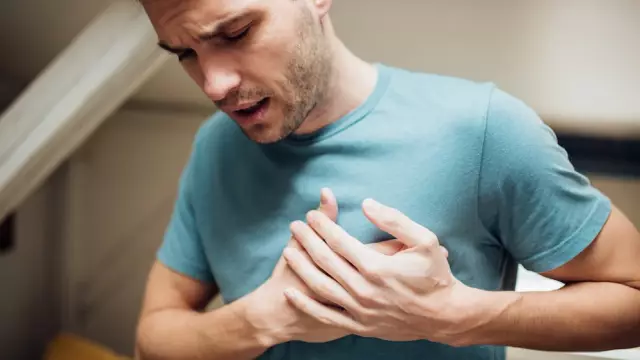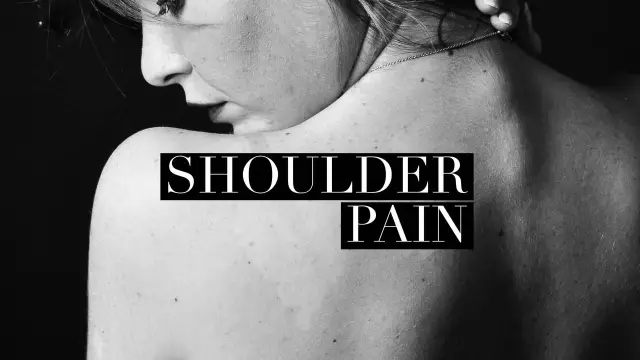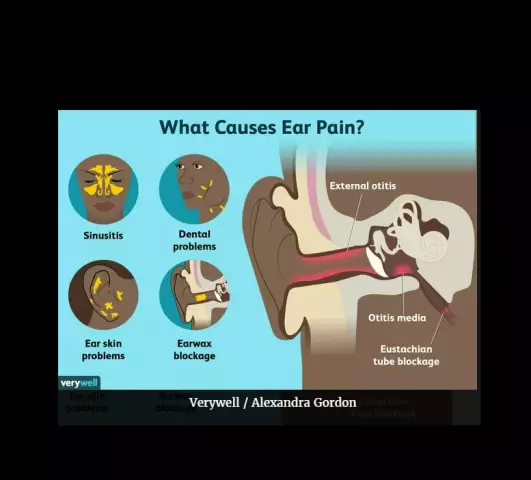- Author Rachel Wainwright [email protected].
- Public 2024-01-15 19:51.
- Last modified 2025-11-02 20:14.
Chest contusion: symptoms, first aid, home treatment
The content of the article:
- Classification
-
Symptoms of a bruised chest
- Broken ribs
- The period of traumatic illness with bruised chest
- Life-threatening conditions
- Provision of medical assistance to victims at the prehospital stage
-
Treating a bruised chest at home
- Drug therapy
- Additional activities
- Forecast
- Video
Chest contusion belongs to the number of chest injuries and according to ICD-10 it has the code S20.2. Breast trauma is called damage to tissues, organs and anatomical structures of the breast, resulting from external mechanical, electrical, thermal, chemical influences.

Chest contusion accounts for most of the total number of injuries
The chest is the anatomical region (upper torso). It is limited:
- top: clavicle, upper edge of the sternum handle, acromioclavicular joints, seventh cervical vertebra;
- below: the border runs along the lower edge of the costal arch from the xiphoid process to the twelfth thoracic vertebra;
- from the abdomen: limited by the diaphragm.
The chest has an extremely complex anatomical structure, since it includes a vital complex: the heart, lungs, organs of the posterior mediastinum. In this regard, specialized doctors - thoracic surgeons are engaged in the treatment of injuries in this area.

The rib cage has a complex anatomical structure
The frequency of mechanical chest injuries in the structure of peacetime injuries is rapidly growing and, according to statistics in recent years, it accounts for 35-50% of the total number of injuries.
Classification
Mechanical damage to the chest is classified as follows:
- open, closed;
- single, multiple;
- isolated, combined (dominant, non-dominant, competing);
- unilateral (right or left), bilateral;
- with or without bone damage (with / without costal valve);
- non-shockogenic, shockogenic (with shock of I, II or III degree);
- with or without damage to internal organs (mono- or multiple-organ); with hemothorax, pneumothorax, hemopneumothorax, contusion of the lung or heart, rupture of large vessels.
Injuries that have caused damage to the internal organs of the chest include the following pathological conditions:
- open, closed and valvular pneumothorax;
- hemopneumothorax;
- hemothorax;
- growing emphysema of the mediastinum;
- cardiac tamponade;
- bruises of the heart and lung;
- chylothorax;
- foreign bodies of the mediastinum, pleura, large bronchi, lungs, trachea, etc.
Symptoms of a bruised chest
For bruises of the soft tissues of the chest, soreness, swelling and subcutaneous hematomas are characteristic at the site of exposure to the traumatic agent. These conditions are subject to outpatient treatment.
Broken ribs
A rib fracture can be easily diagnosed by palpation. In this case, the following symptoms are observed:
- severe local soreness of bone fragments on palpation and compression of the chest in the frontal or sagittal direction;
- pains of intense severity at the site of the fracture, which intensify at the height of inspiration, with coughing, movement, change in body position;
- emphysema of the soft tissues of the chest wall at the site of the fracture (sometimes).

A bruise is often associated with a fractured rib
In some cases, ribs may hurt for a long time after a fracture. However, the pain syndrome is often mild, which poses a certain danger, especially in children. Having lost vigilance, the child can be re-injured, which will lead to more serious consequences.
The period of traumatic illness with bruised chest
Characteristic features of traumatic illness in the acute period with chest contusion:
| Symptoms | Description |
| Pain syndrome | It occurs as a result of fractures of the ribs, clavicles and sternum, ruptures of the parietal pleura, accumulation of blood and other types of biological fluid in the pleural cavity |
| Internal bleeding and acute blood loss syndrome | It develops under the influence of many factors, including rupture of the lung or bronchi, damage to the diaphragm, pneumothorax, hemothorax, lung atelectasis |
| Acute respiratory and cardiovascular failure | Appears due to bruise and cardiac tamponade, acute blood loss, growing mediastinal emphysema, tension pneumothorax |
Finding out the time, mechanism and detailed circumstances of injury is of great importance for diagnosis.
Life-threatening conditions
With a bruised chest, there are several types of life-threatening conditions that require emergency assistance before hospitalization. These include:
| States | Description |
| Upper airway obstruction | It is caused, as a rule, by the accumulation of blood, aspirated vomit, sputum in the respiratory tract, foreign bodies getting there |
| Multiple rib fractures | The most difficult are cases with violation of the integrity of the anterior and lateral parts of the rib cage |
| Open pneumothorax | In such cases, air freely enters the pleural cavity through the wound, which leads to collapse of the lung and the occurrence of ventilation respiratory failure |
| Tension pneumothorax | It occurs in victims with closed injuries of the trachea, large bronchi and multiple ruptures of the lung parenchyma. In the first place are symptoms of severe cardiovascular and respiratory failure, including cyanosis of the skin and visible mucous membranes, hyperemia of the sclera, shortness of breath, rapid shallow breathing |
| Increasing mediastinal emphysema | It occurs when the trachea, bronchi, esophagus or lung are damaged due to air penetration through the rupture of the mediastinal pleura. There is a real danger of compression of the superior vena cava and pulmonary veins with extracardiac tamponade of the heart. The clinical picture is complemented by severe shortness of breath, a feeling of fear, cyanosis of the skin of the face and neck, threadlike and frequent pulse |
| Hemothorax | There is severe dizziness, general weakness, arterial hypotension, flashing before the eyes of the flies, pallor of the skin and visible mucous membranes, rapid threadlike pulse. The affected half of the chest may lag behind breathing |
| Heart tamponade | The clinical picture includes cyanosis of the face, lips, nail beds, rapid threadlike pulse, swelling of the saphenous veins of the neck, a sharp decrease in blood pressure, deafness of heart sounds |
Provision of medical assistance to victims at the prehospital stage
The provision of care for shockogenic breast injuries at the prehospital stage is based on the following principles:
- diagnosis of the patient's emergency and severe injuries;
- compliance with the basic rules of the "golden hour": provision of emergency medical care in the shortest possible time and in the optimal amount, elimination of life-threatening conditions on the spot;
- resuscitation support during transportation of the victim;
- timely delivery of a patient with concomitant chest trauma and severe shock to the hospital (directly to the operating room).
The main tasks in the provision of emergency medical care include:
- identification of the dominant damage,
- assessment of the severity of shock and life-threatening syndrome.
First of all, it is necessary to carry out measures aimed at ensuring the restoration of the patency of the upper respiratory tract, which is achieved by removing blood clots, foreign bodies, contents from the oral cavity and trachea.
Treating a bruised chest at home
In the absence of dangerous consequences of the injury received, treatment can be carried out at home.

A bandage or bandage is applied to the damaged area
Drug therapy
In order to relieve pain, both oral medications and external agents can be used. Most often, non-steroidal anti-inflammatory drugs are prescribed, which have anti-inflammatory, antipyretic and analgesic effects, for example, containing ibuprofen: Nurofen, Dolgit, Ibufen, Faspik, MIG 200.
External remedies - ointments, gels, creams, should be used according to the instructions. The use of non-steroidal anti-inflammatory drugs based on ketoprofen is effective: Ketonal, Bystrumgel, Fastum gel.
In the future, the treatment of a bruised chest after a blow or fall can be carried out using warming compresses. This promotes resorption of the hematoma, as a result of which the symptoms of bruising go away faster.
Depending on the indication, expectorants, respiratory analeptics and bronchodilators may be prescribed.
Additional activities
After 3-5 days after uncomplicated injury, you can begin to perform physiotherapy exercises and breathing exercises. How much time you need to do the exercises, and which ones are most effective, must be agreed with your doctor. They shouldn't cause discomfort.

To speed up recovery, breathing exercises are prescribed.
When ribs are broken, it is helpful to adjust the diet to speed up bone recovery. It is recommended to pay attention to foods containing calcium, such as cottage cheese, sesame seeds.
It is necessary to add dishes to the diet - sources of gelatin, it is contained in broths on bone, aspic dishes, aspic. Lean fish and meat, nuts, fruits and vegetables are useful.
Forecast
With uncomplicated bruises, in case of timely assistance and compliance with the doctor's recommendations, the prognosis is favorable.
If atypical signs appear, especially from the side of breathing, heart or blood vessels, as well as in cases where relief does not come within a few days, you need to consult a doctor - therapist, traumatologist.
Video
We offer for viewing a video on the topic of the article.

Anna Kozlova Medical journalist About the author
Education: Rostov State Medical University, specialty "General Medicine".
Found a mistake in the text? Select it and press Ctrl + Enter.






